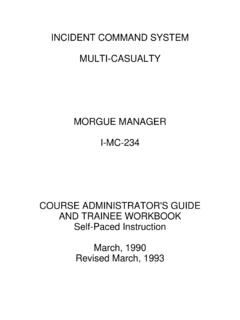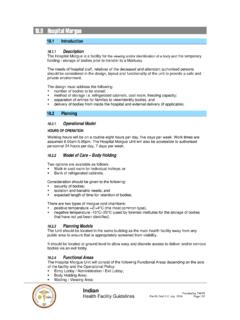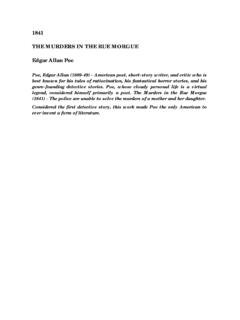Transcription of Flight 93 Morgue Protocols - DMORT REGION IV
1 Flight 93 Morgue Protocols DISCLAIMER This protocol was developed by DMORT III to document the Morgue operation for the United Airlines Flight 93 response. It is intended to serve as an example of a Morgue protocol and does not reflect a formal DMORT protocol . Portions of this document may be used to form the basis of a local disaster Morgue protocol for use in a mass fatality plan. TRIAGE protocol Open bags delivered from scene. Team sorts through materials to separate tissue from other material. Airplane parts and other hardware are routed to [AGENCY] Any items of evidentiary value ( , possible fragments of weapons) are route to [AGENCY] Isolated personal effects are routed to [AGENCY] Review human remains for further analysis. Tissue which will not yield any information in one or more of the following areas -- Pathology (identification, pathology, injury, etc.)
2 -- Anthropology (age, sex, stature, ancestry, etc.) -- Dental -- Fingerprint analysis -- DNA/identification -- Consult DNA Section for guidelines is placed in a red barrel to be included in the common tissue disposition. Tissue with the potential for further identification is placed in a bag and the Victim Processing Record is checked in the left margin to indicate the stations where the specimen should be routed. All specimens go to Photography, Radiography, and DNA. The triage scribe signs and dates the Victim Processing Record. The specimen is routed to Admitting. Human remains associated with personal effects are treated as follows: The PE is removed from the human remains as long as removal will not damage or compromise the remains.
3 Notation about the clothing is entered into the comments section of the Victim Processing Record and the clothing is turned over to [AGENCY]. -- If the human remains are suitable for further analysis, they are processed through the regular channels. [AGENCY] is informed that the human remains will be assigned a Morgue number in Admitting, and they should accompany the remains to Admitting to obtain that number. -- If the remains are not suitable for further analysis, they are placed in the common tissue red barrel. For remains that the PE cannot be removed without possible damage, notify the [AGENCY], and leave effects associated with tissue. Mark [AGENCY] in red marker on the Victim Processing Record. Send specimen through procedures described above. [AGENCY] receives the specimen after all other relevant stations have signed off.
4 **These specimens may be expedited through the systems at the request of the [AGENCY].** . ADMITTING protocol Receive human remains in plastic bag from Triage. Record next sequential Morgue number available and provenience (or other identifying information from the scene) on the flip chart. Label bag of tissue with assigned Morgue number. Do not put provenience or scene information on the bag only the Morgue number. Create a folder with the assigned Morgue number. Place appropriate paperwork, as indicated on the Victim Processing Record, inside the folder. Number all paperwork appropriately. Create a Tyvek tag with the assigned Morgue number. Place the Tyvek tag in the folder, NOT in the bag. Staple Victim Processing Record to front of file. Initial this form. If remains are determined, at any station, to be unrelated, they will be separated and returned to Triage for assessment.
5 One specimen will be designated by the original Morgue number. The second specimen will be admitted into the identification process according to the above procedures and receive new paperwork. All paperwork for each specimen should have reference to the Morgue number of the other specimen. RADIOLOGY protocol Turn on processor at beginning of the day. Hit the run button. Processor will be ready in approximately 15 minutes. Ready light will come on when processor is ready. Gloves will be worn at all times Place cassette inside plastic cover. Place remains on cassette. Depending on the size of the cassette, several items may be radiographed on the same film. Label the remains with the corresponding Morgue number with the lead numbers provided. Lead numbers should be placed as close to the specimen as possible. Do not place multiple specimens together if the Morgue numbers run from 0 to 1 (example, 60 with 61).
6 Attempt to place the remains in anatomical position when possible. The Anthropology or Pathology team will assist as needed. Process the film in the darkroom. Return the film to the imaging area. It is useful to have one person outside the Morgue to transport and process the film from the Morgue door. This eliminates signing in and out, and having to put on and take off PPE. Review the film for adequate exposure and proper labeling. Film should have proper Morgue number label along with MFI name on the film. If remains need to be repositioned to reflect anatomical position of the body part, take an additional radiograph. [AGENCY] is notified of any unusual findings ( , possible weapons or pieces of weapons). The scribe completes the Radiology Victim Processing Record initials logbook places films in corresponding x-ray folder.
7 If multiple remains are included on one film, note on outside of x-ray folder. Place up to twenty specimen radiographs in one envelope. signs the Victim Processing Record on the front of the folder If remains are not received in numerical order, note missing remains for future reference. If specimen is not received by the end of the day, contact Morgue Manager. End of day clean-up Use disinfectant spray or wipes on all equipment, cassettes and table. Turn off x-ray equipment and processor. Lift the lid of the processor for ventilation When radiograph is requested for review by another area, a representative of that area will sign it out with the date and time and sign back. PHOTOGRAPHY protocol Specimen is received and placed on white background (photo copy stand). Place right-angle metric rule next to specimen.
8 Add extension ruler if required. Place Tyvek tag (from folder) with Morgue number next to specimen. Shoot photo. Record in Photodocument Log: Date Film roll number Photo number Morgue number. Add a letter suffix for subsequent photos of the same specimen, , 32, 32A, 32B. Camera settings Notes, as f needed -- Dental -- Perforations in tissue -- Correlation of Morgue numbers -- PE if personal effects are in the photo Sign and date the Victim Processing Record. Label: Exposed (used) film with the photo roll number and the MFI name Exterior of film canister lid with film roll number Inside of film canister lid lid with MFI name Ziplock baggie with MFI name and photo roll number Place photo roll and Photodocument Log in baggie and seal.
9 Document Photo roll numbers and specimen shots in the Photo Log. If a specimen comes back to be re-photographed, look up the Morgue number in the Photodocument Log to determine the last number/suffix used so that the new photograph can receive the correct sequential number. For example, if specimen 32 had three photographs taken when it originally came through, those photos are numbered 32, 32A, and 32B. If 32 comes back for more photos, they should be labeled 32 C, 32 D, etc. Trooper takes possession of film and the original Photodocument Log. He will hand-deliver this directly to [AGENCY]. The Trooper will keep a copy the Photodocument Log for himself. A copy should also be retained in the Photography Section. One set of photographs was made to place in the original postmortem files. A second set is placed in the postmortem file copies maintained by DMORT .
10 [AGENCY] maintains all original film negatives. ANTHROPOLOGY protocol The Anthropological Analysis is completed by a team consisting of 2 anthropologists and 1 scribe. The human remains are received and placed examination table. Morgue number is verified on file and specimen bag. Anthropologists: Assess biological parameters Review Pathology and Dental forms for consistency (bone, side, biological parameters, etc.) with Anthropology assessment. If there is a discrepancy, the team consult the other teams(s) and reach a consensus on the assessment. Scribe: Locates X-ray and places it on light box for review. Transcribes information dictated by Anthropologists to Anthropology Examination form. Completes Anthro Log for each specimen Anthropologist signs and dates Anthropology Examination Form and the Victim Process Record.









